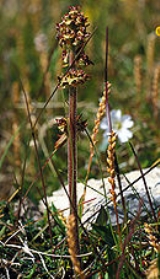
Saxifraga hieracifolia
Encyclopedia
Saxifraga hieracifolia (common name
s: hawkweed-leaved saxifrage, hawkweed-leaf saxifrage, stiff stem saxifrage or stiff-stemmed saxifrage) is a species of saxifrage
distributed all over the high arctic
and some alpine
areas like Norway
and the Carpathian Mountains
, with a few isolated populations in the Central Eastern Alps
of Austria
and the Massif Central
of France
. It is generally not very common.
It grows to 10–20 cm tall. The leaves
are oblong to rhombic, thick, and remotely toothed. The stem is single, stout and thick, and densely glandular. The flower
s are produced in dense clusters, small and inconspicuous, with greenish to purplish petals.
It grows in meadow
s, on solifluction
soil, and in places with well-developed moss
growth.
Common name
A common name of a taxon or organism is a name in general use within a community; it is often contrasted with the scientific name for the same organism...
s: hawkweed-leaved saxifrage, hawkweed-leaf saxifrage, stiff stem saxifrage or stiff-stemmed saxifrage) is a species of saxifrage
Saxifrage
Saxifraga is the largest genus in the family Saxifragaceae, containing about 440 species of Holarctic perennial plants, known as saxifrages. The Latin word saxifraga means literally "stone-breaker", from Latin + ...
distributed all over the high arctic
Arctic
The Arctic is a region located at the northern-most part of the Earth. The Arctic consists of the Arctic Ocean and parts of Canada, Russia, Greenland, the United States, Norway, Sweden, Finland, and Iceland. The Arctic region consists of a vast, ice-covered ocean, surrounded by treeless permafrost...
and some alpine
Alpine climate
Alpine climate is the average weather for a region above the tree line. This climate is also referred to as mountain climate or highland climate....
areas like Norway
Norway
Norway , officially the Kingdom of Norway, is a Nordic unitary constitutional monarchy whose territory comprises the western portion of the Scandinavian Peninsula, Jan Mayen, and the Arctic archipelago of Svalbard and Bouvet Island. Norway has a total area of and a population of about 4.9 million...
and the Carpathian Mountains
Carpathian Mountains
The Carpathian Mountains or Carpathians are a range of mountains forming an arc roughly long across Central and Eastern Europe, making them the second-longest mountain range in Europe...
, with a few isolated populations in the Central Eastern Alps
Central Eastern Alps
The Central Eastern Alps comprise the main chain of the Eastern Alps with its highest peaks, located between the Northern Limestone Alps and the Southern Limestone Alps, from which they differ in geological composition....
of Austria
Austria
Austria , officially the Republic of Austria , is a landlocked country of roughly 8.4 million people in Central Europe. It is bordered by the Czech Republic and Germany to the north, Slovakia and Hungary to the east, Slovenia and Italy to the south, and Switzerland and Liechtenstein to the...
and the Massif Central
Massif Central
The Massif Central is an elevated region in south-central France, consisting of mountains and plateaux....
of France
France
The French Republic , The French Republic , The French Republic , (commonly known as France , is a unitary semi-presidential republic in Western Europe with several overseas territories and islands located on other continents and in the Indian, Pacific, and Atlantic oceans. Metropolitan France...
. It is generally not very common.
It grows to 10–20 cm tall. The leaves
Leaf
A leaf is an organ of a vascular plant, as defined in botanical terms, and in particular in plant morphology. Foliage is a mass noun that refers to leaves as a feature of plants....
are oblong to rhombic, thick, and remotely toothed. The stem is single, stout and thick, and densely glandular. The flower
Flower
A flower, sometimes known as a bloom or blossom, is the reproductive structure found in flowering plants . The biological function of a flower is to effect reproduction, usually by providing a mechanism for the union of sperm with eggs...
s are produced in dense clusters, small and inconspicuous, with greenish to purplish petals.
It grows in meadow
Meadow
A meadow is a field vegetated primarily by grass and other non-woody plants . The term is from Old English mædwe. In agriculture a meadow is grassland which is not grazed by domestic livestock but rather allowed to grow unchecked in order to make hay...
s, on solifluction
Solifluction
In geology, solifluction, also known as soil fluction, is a type of mass wasting where waterlogged sediment moves slowly downslope, over impermeable material. It occurs in periglacial environments where melting during the warm season leads to water saturation in the thawed surface material ,...
soil, and in places with well-developed moss
Moss
Mosses are small, soft plants that are typically 1–10 cm tall, though some species are much larger. They commonly grow close together in clumps or mats in damp or shady locations. They do not have flowers or seeds, and their simple leaves cover the thin wiry stems...
growth.

